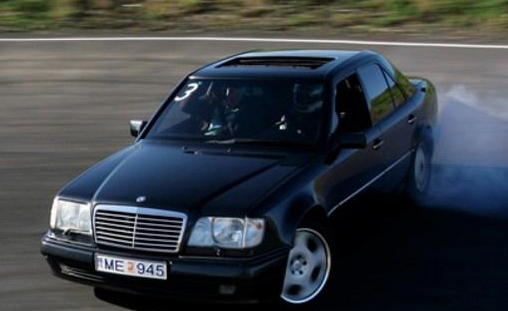Research into the effects of alcohol on driving ability is fascinating and voluminous. One area of study has been testing drinking drivers on a closed course track. This type of testing has advantages as it is more realistic than laboratory studies but can involve a certain risk as this German study illustrates.
BARTL, G., C. BRANDSTATTER, A. HOSEMANN, AND C. REITER. “Saccadic Eye Movements and Reactions of Drivers With Low Alcohol Concentrations’ [German}, Blutalkohol, 35: 124-138, 1998 (1 Table, 5 figures, 9 references)
his study is listed in my book as WOA50305.
The circular driving course was approximately 1.5 miles long and driving was of approximately 15 minutes duration. To make the driving more realistic, it was conducted at night (when most alcohol-impaired motor vehicle collisions occur) and in winter. Although testing was stopped if it snowed or the course was icy. The subjects drove a specially instrumented Mercedes W124 300D automobile, which could also track the response and movements of the eyes of the drivers. The drivers were instructed to maintain a speed of approximately 45 km/h around the track.
Surprise Traffic Situation
During the last 30-60 seconds of the test, a horn would sound from the right, activated by a photoelectric beam, which signaled the surprise traffic situation to begin. This surprise (to the tested driver) traffic situation was conducted in order to make the closed course driving more realistic in which the unexpected often occurs during actual driving on the highways. The sequence of events was:
-
A pedestrian walked across the track (at a safe distance) and entered one of two parked cars and turned on the headlights.
-
On the left side of the road (at a safe distance) there was a bicyclist with a light on.
-
A VW car came along in the opposite direction.
-
There was a road junction with 3 traffic signs, which did not require any response from the tested driver.
-
Two more pedestrians were walking on the left side of the track (again at a safe distance).
-
Finally a grey foam obstacle (3 feet x 1 ½ feet x 1 ½ feet) appeared which required the driver to avoid.
The surprise traffic situation is shown in Figure 1.

Versuchsfahzeug= “test vehicle”
The closed course test was conducted on 23 sober and 25 drinking subjects. The drinking subjects consumed alcohol of their choice (beer, wine, vodka or rum). The mean BAC of the drinking subjects was approximately 0.070 g/100mL (range 0.054 and 0.092 g/100mL) at the beginning of the test drive.
Reaction to the Grey Foam Barrier
The reaction time of the drinking and sober drivers, the number of collisions and near misses with the grey foam obstacle are listed in Table 1.

Interestingly, drinking drivers were able to remember less of what happened in the surprise traffic situation than sober drivers (3.7 items vs 5.9 items).
Fortunately there were no injuries or damage except for one drinking driver who caused damage to the front spoiler of the Mercedes when it got stuck on an icy patch on the side of the track.
Conclusions
Even though this closed course driving was conducted at low speed of 45 km/h (27 mph), impairment of driving ability was shown in BACs less than 0.08 g/100mL. The authors state that their results are in agreement with the Borkenstein Grand Rapids Study, which also showed impairment of driving ability occurs below 0.08 g/100mL.
References
Wigmore on Alcohol: Courtroom Alcohol Toxicology for the Medicolegal Professional, Chapter 5.03 Closed-Course Driving Studies, Irwin Law, Toronto, 511pp, 2011




